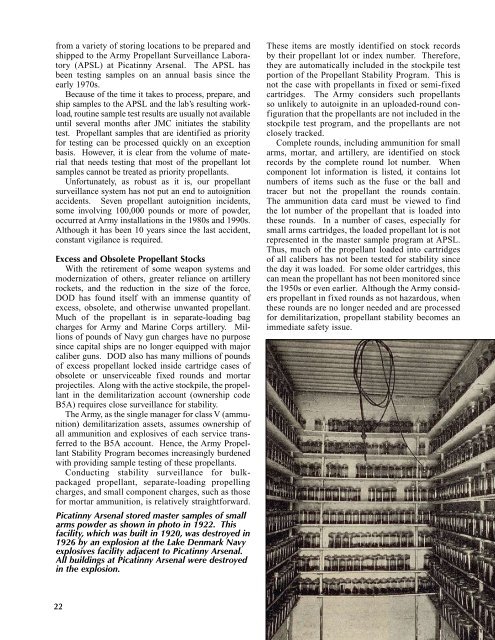Do Stryker Brigade Combat Teams Need Forward Support ...
Do Stryker Brigade Combat Teams Need Forward Support ...
Do Stryker Brigade Combat Teams Need Forward Support ...
Create successful ePaper yourself
Turn your PDF publications into a flip-book with our unique Google optimized e-Paper software.
from a variety of storing locations to be prepared and<br />
shipped to the Army Propellant Surveillance Laboratory<br />
(APSL) at Picatinny Arsenal. The APSL has<br />
been testing samples on an annual basis since the<br />
early 1970s.<br />
Because of the time it takes to process, prepare, and<br />
ship samples to the APSL and the lab’s resulting workload,<br />
routine sample test results are usually not available<br />
until several months after JMC initiates the stability<br />
test. Propellant samples that are identified as priority<br />
for testing can be processed quickly on an exception<br />
basis. However, it is clear from the volume of material<br />
that needs testing that most of the propellant lot<br />
samples cannot be treated as priority propellants.<br />
Unfortunately, as robust as it is, our propellant<br />
surveillance system has not put an end to autoignition<br />
accidents. Seven propellant autoignition incidents,<br />
some involving 100,000 pounds or more of powder,<br />
occurred at Army installations in the 1980s and 1990s.<br />
Although it has been 10 years since the last accident,<br />
constant vigilance is required.<br />
Excess and Obsolete Propellant Stocks<br />
With the retirement of some weapon systems and<br />
modernization of others, greater reliance on artillery<br />
rockets, and the reduction in the size of the force,<br />
DOD has found itself with an immense quantity of<br />
excess, obsolete, and otherwise unwanted propellant.<br />
Much of the propellant is in separate-loading bag<br />
charges for Army and Marine Corps artillery. Millions<br />
of pounds of Navy gun charges have no purpose<br />
since capital ships are no longer equipped with major<br />
caliber guns. DOD also has many millions of pounds<br />
of excess propellant locked inside cartridge cases of<br />
obsolete or unserviceable fixed rounds and mortar<br />
projectiles. Along with the active stockpile, the propellant<br />
in the demilitarization account (ownership code<br />
B5A) requires close surveillance for stability.<br />
The Army, as the single manager for class V (ammunition)<br />
demilitarization assets, assumes ownership of<br />
all ammunition and explosives of each service transferred<br />
to the B5A account. Hence, the Army Propellant<br />
Stability Program becomes increasingly burdened<br />
with providing sample testing of these propellants.<br />
Conducting stability surveillance for bulkpackaged<br />
propellant, separate-loading propelling<br />
charges, and small component charges, such as those<br />
for mortar ammunition, is relatively straightforward.<br />
Picatinny Arsenal stored master samples of small<br />
arms powder as shown in photo in 1922. This<br />
facility, which was built in 1920, was destroyed in<br />
1926 by an explosion at the Lake Denmark Navy<br />
explosives facility adjacent to Picatinny Arsenal.<br />
All buildings at Picatinny Arsenal were destroyed<br />
in the explosion.<br />
22<br />
These items are mostly identified on stock records<br />
by their propellant lot or index number. Therefore,<br />
they are automatically included in the stockpile test<br />
portion of the Propellant Stability Program. This is<br />
not the case with propellants in fixed or semi-fixed<br />
cartridges. The Army considers such propellants<br />
so unlikely to autoignite in an uploaded-round configuration<br />
that the propellants are not included in the<br />
stockpile test program, and the propellants are not<br />
closely tracked.<br />
Complete rounds, including ammunition for small<br />
arms, mortar, and artillery, are identified on stock<br />
records by the complete round lot number. When<br />
component lot information is listed, it contains lot<br />
numbers of items such as the fuse or the ball and<br />
tracer but not the propellant the rounds contain.<br />
The ammunition data card must be viewed to find<br />
the lot number of the propellant that is loaded into<br />
these rounds. In a number of cases, especially for<br />
small arms cartridges, the loaded propellant lot is not<br />
represented in the master sample program at APSL.<br />
Thus, much of the propellant loaded into cartridges<br />
of all calibers has not been tested for stability since<br />
the day it was loaded. For some older cartridges, this<br />
can mean the propellant has not been monitored since<br />
the 1950s or even earlier. Although the Army considers<br />
propellant in fixed rounds as not hazardous, when<br />
these rounds are no longer needed and are processed<br />
for demilitarization, propellant stability becomes an<br />
immediate safety issue.<br />
JULY–AUGUST 2008







